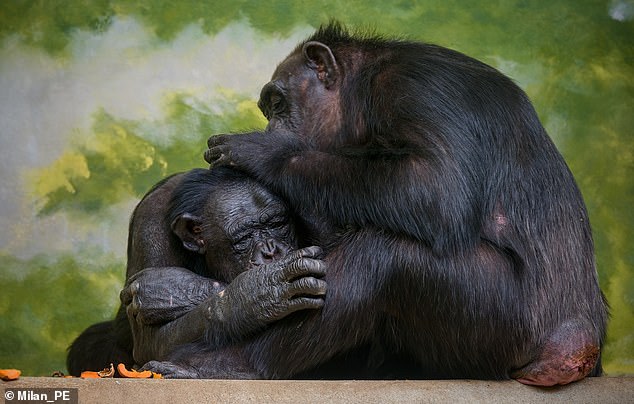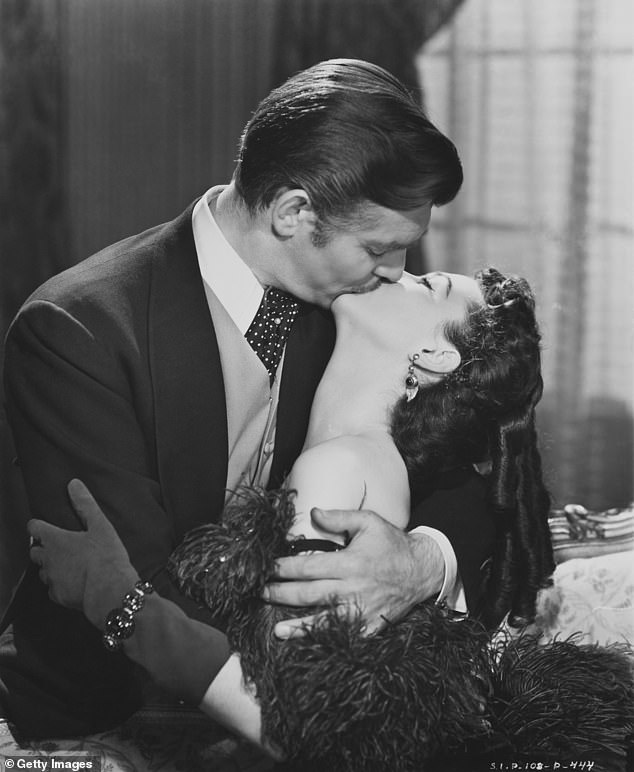Scientists discover where KISSING came from - and it will make your skin crawl
- READ MORE: The first kiss between partners can define an entire relationship
It's one of the most primitive human urges, yet why exactly we kiss has intrigued scientists for centuries.
Now, a researcher has a new theory – and it may make you think twice about leaning in for a smooch.
Professor Adriano Lameira, an evolutionary psychologist at Warwick University, claims kissing has its origins in our hairy human ancestors millions of years ago.
The act of sucking very slightly with pursed lips was once a clever technique to remove tics and lice from each other's fur, he argues.
It was only around a few million years ago that it started to gain sexual connotations and become an act that preceded mating.
Other theories as to why we kiss range from hardening our immune system by exchanging bacteria, to a form of 'sniffing' for social inspection.
But this hypothesis – known as 'the groomer's final kiss' – adds a new evolutionary origin for human kissing, depicted on the big screen for more than 100 years.

Pictured, Princess Leia (Carrie Fisher) and Han Solo (Harrison Ford) share a kiss in 'The Empire Strikes Back' (1980)

Humans are apes, and our closest living relatives include gorillas and chimpanzees (pictured)
In his new study, published in Evolutionary Anthropology, Professor Lameira (@lameira_adriano) says the kiss is yet another relic from our evolutionary past.
Millions of years ago, a slight sucking action with protruded lips would have been an essential form of grooming to remove parasites, dead skin and debris.
Professor Lameira thinks this unique session between our hairy ancestors would have been performed all over the body, ending with mouth-to-mouth contact.
Very gradually, as our ancestors evolved and became less and less hairy, these grooming sessions would have become shorter, but they would always have ended with mouth-to-mouth.
Eventually the all-over grooming session died out, but the final mouth-contact stage remained – becoming what we know to be the kiss.
He says in his paper: 'The hygienic relevance of grooming decreased over human evolution due to fur-loss.
'But shorter sessions would have predictably retained a final “kissing” stage, ultimately remaining the only vestige of a once ritualistic behavior for signaling and strengthening social and kinship ties in an ancestral ape.'
Professor Lameira estimates that our ancestors developed the fur-sucking technique around 7 million years ago, when they moved from the trees to the ground.

Today, kissing has a multitude of uses - including a signifier of romantic and sexual attraction, commonly depicted in the movies. Pictured, Hugh Grant and Andie MacDowell in 'Four Weddings and a Funeral' (1994)
'This made grooming important for hygienic purposes given the high parasitic load on the ground,' Professor Lameira told MailOnline.
Our ancestors then 'became a kissing ape' around 2-4 million years ago, when they lost all their fur.
More recently, the earliest recorded evidence of kissing appears in texts written in Mesopotamia, the ancient region located in the eastern Mediterranean, in about 2500 BC.
All of today's many kissing forms evolved from the lice-removal technique, Professor Lameira argues – from a simple peck on the cheek as a greeting to a religious blessing on the hand or the head.
It also accounts for what is arguably one of the most important functions of the kiss, commonly depicted in the movies.
The kiss on the lips to signify erotic or sexual desire between romantic partners was something the Romans referred to as the 'savium'.
However, the exact reason for why kissing gained a sexual connotation 'remains more speculative', the academic adds.
What's more, further research may be needed to explain the close connection between the desire to kiss and the urge to have sex.

Today, kissing has a multitude of uses - including a signifier of romantic and sexual attraction, commonly depicted in the movies. Pictured, Rhett Butler (Clark Gable) and Scarlett O'Hara (Vivien Leigh) in 'Gone with the Wind' (1939)
'Kissing with a sexual intent is but a special case of a much more general behaviour,' Professor Lameira told MailOnline.
'Only once kissing was used as a general convention for showing affection, could kissing become a mutual mouth-to-mouth act.'
No other members of the animal kingdom are known to kiss sexually like humans do, by protruding one's lips and doing the slight suction movement.
Professor Lameira concludes that the kiss has been 'turned into a crystalized symbol of trust and affiliation'.
'Few natural human signals carry the symbolism and social sanctions of kissing,' he says.
'Evidence supports that kissing isn't a derived signal of affection in humans.
'It instead represents a surviving devolved, vestigial form of primate grooming that conserved its ancestral form, context, and function.'


























































































































































































